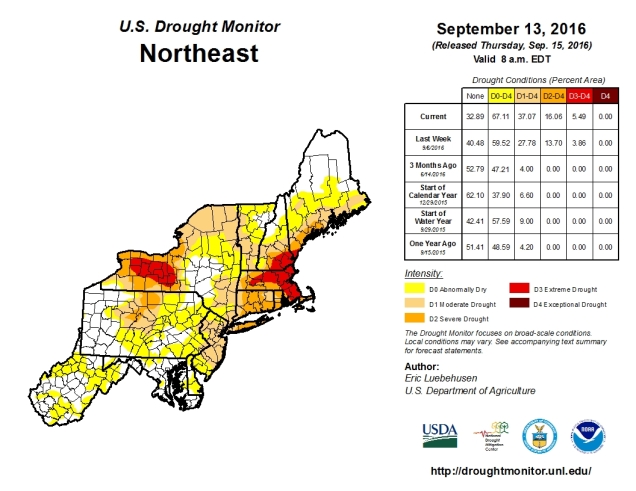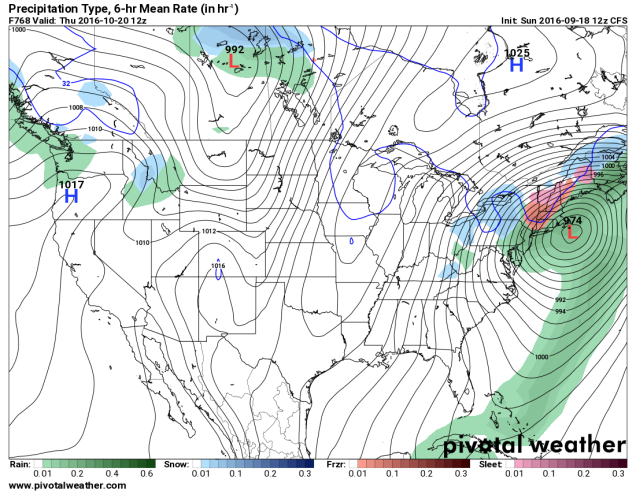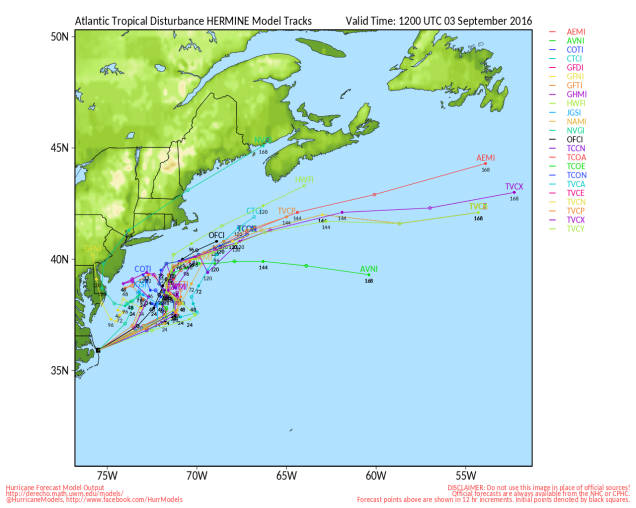By now you’ve probably heard, there’s a new storm in the Atlantic, and it’s named Matthew. OK, you probably knew that, because the hype machine from the media has gone into overdrive for the past few days. Why has that happened? Some of the computer forecast models have indicated that there’s a possibility that Matthew could hit the East Coast? How likely is that? We’ll delve into that shortly. First, we’ll get into what we do know.

As of 2pm EDT on Friday, Matthew was a Category 3 Hurricane on the Saffir-Simpson scale, with maximum sustained winds of 120 mph.The storm was centered a little less than 100 miles off the northern coast of Colombia, and was moving off towards the west-southwest at 12 mph. A Tropical Storm Warning is in effect for the coast of Colombia from the Colombia/Venezuela border to Riohacha.
It is actually pretty rare to have a storm impact the ABC Islands (Aruba, Bonaire, Curacao) and northern South America. There have been a few wind gusts to near tropical storm force in Aruba and Bonaire today, but for the most part, it’s just been a breezy and cloudy day in an area that usually is sunny and warm. When Matthew crossed the island of Martinique a few nights ago, it produced sustained winds of 40 mph and a gust to 60 mph at the airport in St. Pierre, with reports of gusts of up to 89 mph on the island. There was several reports of damage across the island.
OK, that’s what we know. Here’s what we’re fairly sure about. Matthew should turn more towards the northwest and eventually north this weekend with some more strengthening possible. It may become a category 4 hurricane. Unfortunately, it is also going to pass very close to Jamaica late Sunday and early Monday. It may even make landfall on the island. Even a glancing blow will likely result in widespread damage across the island. After that, Matthew should continue northward, and it will pass very near or over extreme western Haiti or eastern Cuba before heading into the Bahamas. Some slight weakening is possible due to interaction with the land areas, but Matthew should still be a strong hurricane (Category 2 or 3) when it enters the Bahamas.

Now, the part that nobody knows with any certainty – what happens after Matthew gets into the Bahamas. This is the big question, and a lot of it has to do with what the upper-level pattern looks like. A trough of low pressure will be starting to move out of the Northeast while another one moves into the Great Plains. In between, a ridge of high pressure will be moving into the East. Exactly how quickly these features move eastward will determine which way Matthew goes.


As you can see from the images above, there are dozens of possibilities as to where Matthew can go. Based on the most recent model runs, a track through the Bahamas and then northward off the Carolinas is the most likely outcome, but there are still some models that have the storm stall in the Bahamas or even drift closer to Florida or possibly into the Gulf of Mexico. Once it gets up towards the Carolinas, there are even more possibilities to consider. The storm could continue up the coast and threaten the Northeast. It could start to turn northeastward and threaten Atlantic Canada. It could head harmlessly out to sea. At least one model shows it doing nearly all of the above! This model has it head out to sea, then hook back northwestward, and head towards eastern New England and Nova Scotia/New Brunswick.
At this point, we really have to wait and see how the pattern evolves before we’ll have a better idea as to what Matthew is going to do. If it is going to impact the Northeast, the time frame would be towards next weekend.So, keep an eye on Matthew’s progress if you have plans for that time frame.


























